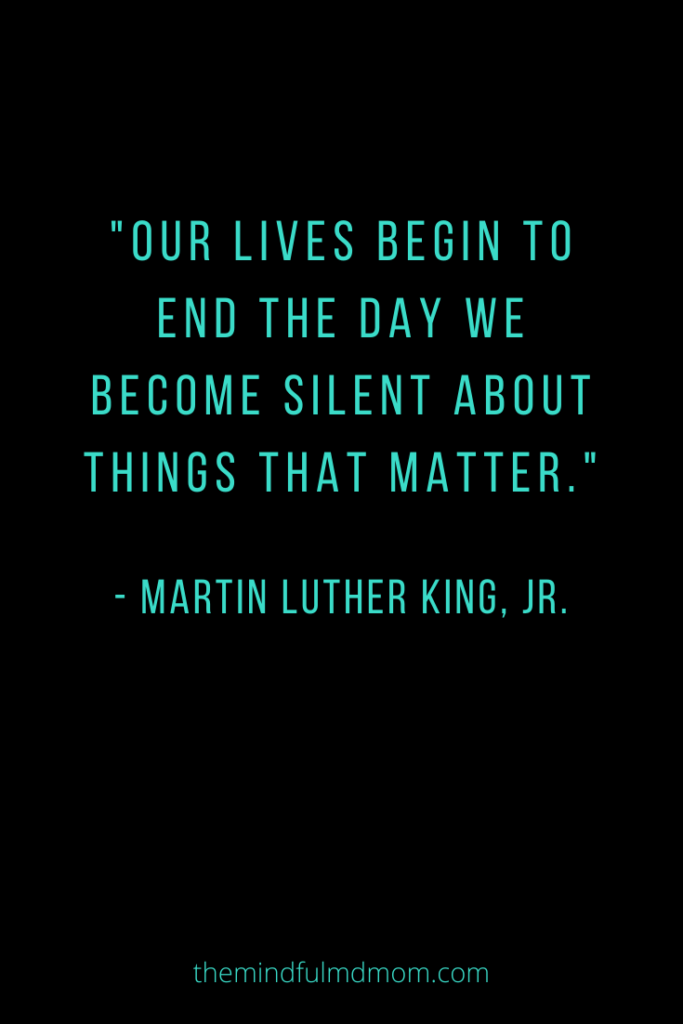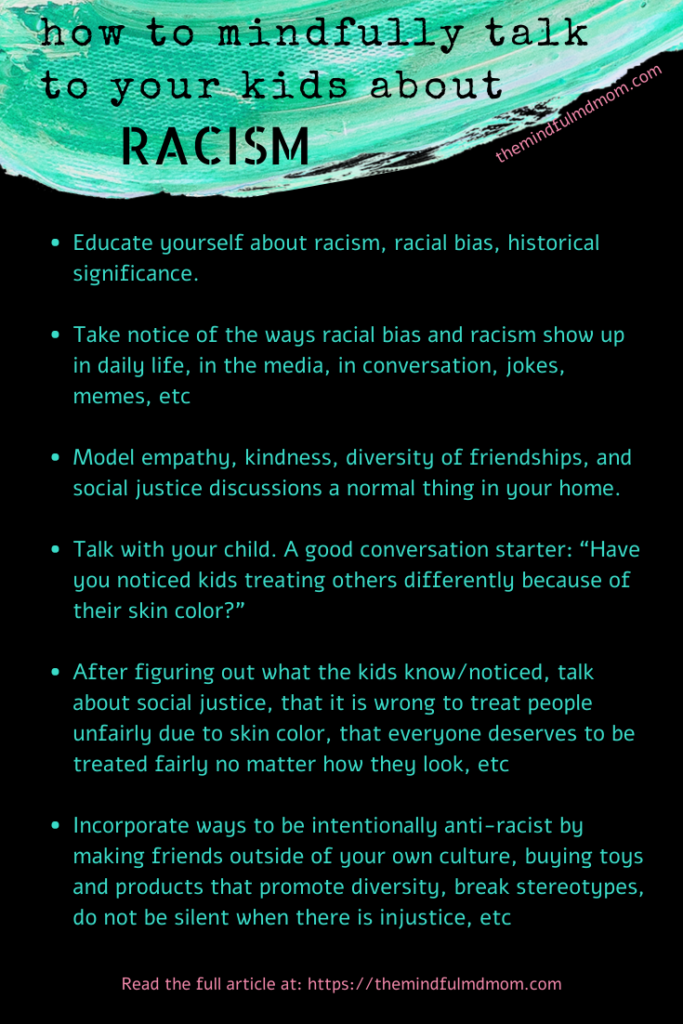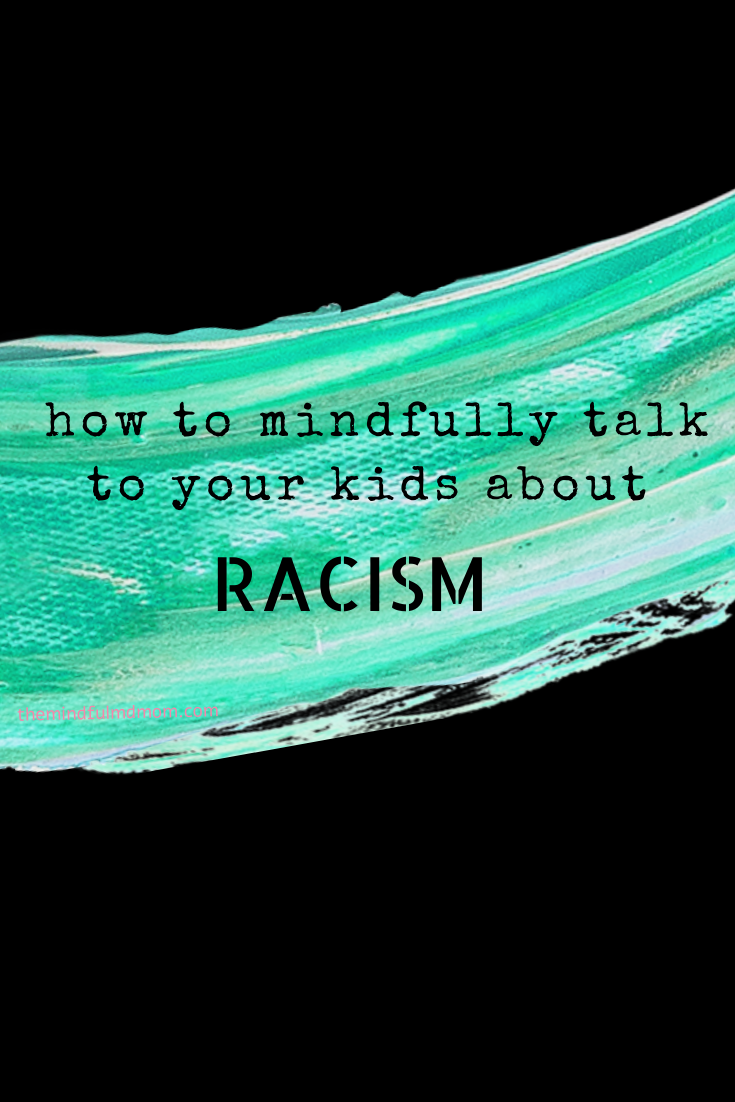How to Mindfully Talk to Your Kids about Racism
by Nadia Sabri MD
Many people feel uneasy talking about racism because it seems “wrong” or politically incorrect to “see” color. However, the fact is that racism is very real for many, many people. To change the conversation for the better, we must acknowledge and accept racism as a part of our collective histories. Learning how to mindfully talk to your kids about racism can help make social justice discussions a normal and natural conversation in your family.

Being silent, looking away, being “neutral” IS a response—the wrong one. Denial of racism or shifting focus to one’s personal frame of reference reflects privilege and adds to the ongoing trauma and injustice of people of color and Black communities.
Historically speaking, it wasn’t until the 1960s Civil Rights Movement that legal racism was abolished. However, it didn’t actually stop or prevent racism from still continuing. As a result, many injustices and oppression have occurred against large segments of our population: minorities, immigrants, refugees, Black communities, anyone who looks or speaks differently.
Of all the groups, Black communities have been affected the most. Read more on the history of Jim Crow laws for separate but not equal treatment.
Systemic racism in daily life, in education, in the healthcare system, social determinants of health (SDoH), exposure to violence, adverse early childhood experiences (ACEs).
Racism is a human rights issue, a public health crisis, negatively affects the health and wellbeing of children, and shortens life spans.
As people, as professionals, as parents it is our personal and ethical responsibility to call out and stop injustice.
As a society, we must choose to change.
What is Racism?
By definition, racism is the belief that one’s race makes them superior to another person.
Racism is a social disease that is taught in families and communities by words, actions, behaviors. This disordered thought process results in both direct and indirect actions that can oppress, antagonize, harass, or alienate people of a different race.
The good news is that if something is learned, it can also be unlearned.
How to mindfully talk to your kids about racism?
Don’t make it awkward or pretend it doesn’t exist.
Kids are sponges and absorb A LOT from their home, social, and physical environments. They may have already experienced racism, either directly or indirectly. They may not have fully understood its implications.
That’s where we as parents come in, to help our kids make sense of what is happening in the world, why social justice is important, and how to make positive changes in community.
If this topic is made to be awkward, your child will see it from your eyes. Pretending racism doesn’t exist indicates that if you don’t talk about it, it means you either agree with it or don’t feel it is necessary enough to discuss.
Unless this is the intended meaning, it is better to start the conversations with yourself, your family, and your community.
Unlearn racial bias
Start by educating yourself and reflecting on ways that racial bias and racism shows up in daily life.
We humans tend not to notice things that don’t affect us directly; however, by not noticing racial bias, we may add to the problem and not even realize it.
Truth: just because we don’t notice something doesn’t mean it isn’t there.
Talk with your child about what they have heard, seen, felt regarding racism.
“Have you noticed kids treating others differently because of their skin color?” is a great conversation starter.
According to the American Academy of Pediatrics, “children exposed to society will gain fluency in racial bias even if their parents do nothing”.
Children as young as 6 months can pick up racial differences. Kids don’t think different is “bad” unless they learn it from somewhere, usually a social source.
By age 2-4 years, kids start to internalize racial bias, acting out and reflecting the things they learn from other people, whether it be from tv shows, in the community, at home, etc.
By age 12, children become set in the racial biases that have been taught to them, directly or indirectly.
Take notice of racism in daily life and then consciously choose to not perpetuate it.
From the toys we buy, the conversations we have, the comments we make, our body language when people of different colors walk by, we can add to racism or decrease it.

Ways to be anti-racist:
- Notice representation of toys of color vs white toys. Representation indicates importance or worthiness.
- Buy toys of diversity, not just White.
- Say hello to everyone, especially those who are Black. Many people look away or walk fast when passing a person of color. This is so insulting, as if the other person isn’t even human enough for a hello. It’s not ok. And kids notice this covert but very present racism.
- Stop using the words “dark” or “darkness” as a bad thing. Affirmation: All humans are worthy, regardless of skin color. It is important to understand that Black lives matter, are worthy, beautiful, important.
- Add diversity in your social circle. Make friends with people from different backgrounds and cultures, religions, and lifestyles.
- Acknowledge and verbalize appreciation of diversity.
- if your child makes a comment about someone of a different culture or color, instead of “shhhh!” and looking away embarrassed, stop and acknowledge the differences in positive way. “What a cute baby!”, “yes, such beautiful hair!”
Or better yet, have a conversation with the person.
- Minimize “otherness”. Through verbal and nonverbal language, show your children that there is nothing to fear. Humans are humans. Our differences make us unique and our similarities connect us to each other.
- Model empathy and compassion in your life.
- Make it a point to notice injustice and misrepresentation in media when misrepresentations (ie. person of color as a janitor, terrorist, or drug dealer but rarely the hero, princess, etc)
- Communicate with your children often to treat others with respect and dignity, not arrogance or superiority. Skin color is nothing to feel superior about as we have no control over our appearance.
- Ask questions and encourage your children to ask questions, too. Discuss social responsibility.
Please remember that racists are not born, they are created. Fortunately, what is learned can also be unlearned—if we choose to do so.
Mindful MD Mom Asks:
How do discuss racial bias with your family? What are some ways you model anti-racism?
285 - 285Shares
- 285Shares
285




No Comments